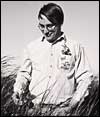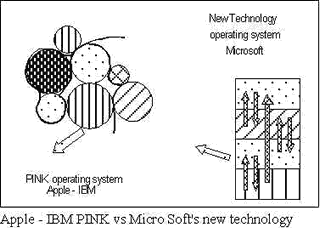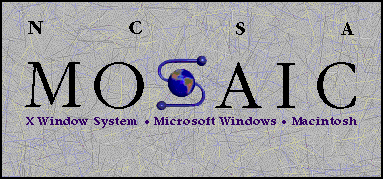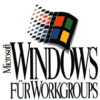click on the home button to go to the home page
|
The Industrial Era 1991 - 1992 Trend setting are Multi Media machines. Sound, picture, video and TV features are becoming highly in demand. New OS technologies are being developed. |
pre history | antiquity
| pre industrial era | industrial
era
1947 - 1950 -
1952 - 1955 - 1958
- 1961 - 1963 - 1965
- 1969 - 1970 - 1972
- 1974 - 1976 - 1978
- 1980 - 1981 - 1982
- 1984 - 1986 -
1989 - 1991 - 1993 -
1994 - 1996 - 2000
- 2002
| Related Articles |
| Related Resources |
|
pre history |
![]() October
5, 1991 05:41:06 GMT: The young student Linus Torvalds from Finland releases
Linux version 0.02 which is the first official release. Linux is a UNIX like
OS based on POSIX which is distributed with free source code.
October
5, 1991 05:41:06 GMT: The young student Linus Torvalds from Finland releases
Linux version 0.02 which is the first official release. Linux is a UNIX like
OS based on POSIX which is distributed with free source code.
Linus Torvalds wrote in the announcement:
"I've enjoyed doing it, and somebody might enjoy looking at it and even modifying it for their own needs"

Linus Thorvald (5)
This will be the best candidate for the understatement of the decade to come!
It is the picture of a penguin that
will become the logo for the Linux community.
that
will become the logo for the Linux community.
![]() CERN seminar
on WWW
CERN seminar
on WWW
CERN holds a seminar on the newly developed World Wide Web. With input gathered
at conferences and online discussion, the Web continues to evolve. (6)
![]() E*trade founded
E*trade founded
E*trade, an online investment company, starts offering electronic trading through
online services in 1992. The company launches its Web site in 1996 and goes
public in 1997 as the Web's first online public offering.(6)
![]() After, in fact
the failure of MS-DOS 4.0, Microsoft introduces MS-DOS 5.0 to the market. This
version can only be used optimally on machines with a CPU of 80386 or higher.
The new version has a limited task swapping, a GUI users surface and does use
completely an expanded and extended memory. In principle, all drivers -xx386
and higher- can be stored in the higher part of the memory (high mem). Tools
which were acquired by other manufacturers (such as recover, unformat etc.)
are now an integrated part of the new DOS version, however in a more simple
form.
After, in fact
the failure of MS-DOS 4.0, Microsoft introduces MS-DOS 5.0 to the market. This
version can only be used optimally on machines with a CPU of 80386 or higher.
The new version has a limited task swapping, a GUI users surface and does use
completely an expanded and extended memory. In principle, all drivers -xx386
and higher- can be stored in the higher part of the memory (high mem). Tools
which were acquired by other manufacturers (such as recover, unformat etc.)
are now an integrated part of the new DOS version, however in a more simple
form.
Microsoft did not want to run any risk and has tested the new system thoroughly during an extended Beta test at a scale which was never done before. This was a part why this version was good received by the end-users. Despite this there are still some minor mistakes in the OS.
![]() After a long
wait for the users, Apple launches OS7. Herewith a big leap has been made. Similar
to MS-DOS many optional which had to bought before separately, are now included.
After a long
wait for the users, Apple launches OS7. Herewith a big leap has been made. Similar
to MS-DOS many optional which had to bought before separately, are now included.
![]() IBM and Apple
are collaborating in the field of GUI with as aim to improve the OS/2 concept
and to compete with Microsoft's Windows.
IBM and Apple
are collaborating in the field of GUI with as aim to improve the OS/2 concept
and to compete with Microsoft's Windows.
![]() Toshiba micro
computers increases the capacity of the 3.5" floppy disk to 2.88 Mb., which
gives a doubling of the amount of data that can be stored. The surface of the
flop is made of Barium Ferrite, a mixture which has excellent magnetic characteristics.
IBM is the first manufacturer to include these drives in its computers during
the coming years. Trough this development the disc drives developed in 1989
for 5.25" become obsolete. And the commercial development of 51/4"
diskettes of 10 and 20 Mb is stalled for the moment.
Toshiba micro
computers increases the capacity of the 3.5" floppy disk to 2.88 Mb., which
gives a doubling of the amount of data that can be stored. The surface of the
flop is made of Barium Ferrite, a mixture which has excellent magnetic characteristics.
IBM is the first manufacturer to include these drives in its computers during
the coming years. Trough this development the disc drives developed in 1989
for 5.25" become obsolete. And the commercial development of 51/4"
diskettes of 10 and 20 Mb is stalled for the moment.
![]() The former
Fairchild Semiconductor Laboratory in the USA, the place where the IC originated
(1957-58), becomes a historical monument (East Charleston rd. 844 in Palo Alto
("Silicon Valley").
The former
Fairchild Semiconductor Laboratory in the USA, the place where the IC originated
(1957-58), becomes a historical monument (East Charleston rd. 844 in Palo Alto
("Silicon Valley").
![]() IBM and Apple
designing a new operating system - code name PINK - which have to become the
competitor of the Microsoft dyad: MS-DOS and Windows.
IBM and Apple
designing a new operating system - code name PINK - which have to become the
competitor of the Microsoft dyad: MS-DOS and Windows.
![]() Microsoft announced,
as an answer on the IBM-Apple PINK operating system, the development of
NT - for New Technology -.
Microsoft announced,
as an answer on the IBM-Apple PINK operating system, the development of
NT - for New Technology -.

![]() The
built-up and coherence of the PINK OS is modular and object oriented hence the
developers are expecting that by changing a certain module the coherence and
working of the system does not get lost. The big advantage of this will be that
changes can take place per object.
The
built-up and coherence of the PINK OS is modular and object oriented hence the
developers are expecting that by changing a certain module the coherence and
working of the system does not get lost. The big advantage of this will be that
changes can take place per object.
Contrarily, Microsoft was in favor for a layered structure with NT. Analysts
comented that if one removed or changed one of the layers, the coherence of
the system would not be sufficiently stable. For this reason a total revision
of the system was needed when changing or removing one of the layers. Not a
very efficient way of software maintenance analysts stated.
![]() Hard disc drives
with a diameter of 1.8" (45.72 mm) and a capacity of 20 and 40 Mb are coming
on the market this year, these are primarily meant for pen-books and palmtops.
Hard disc drives
with a diameter of 1.8" (45.72 mm) and a capacity of 20 and 40 Mb are coming
on the market this year, these are primarily meant for pen-books and palmtops.
![]() The sub-mini
hard disc of Integral weighs 3.3 ounces and is 2 inch wide. It has a normal
IDE interface and is faster than 20 ms. The energy use is in the "save"
mode around half a watt and in the sleep mode 16 mwatt. (3).
The sub-mini
hard disc of Integral weighs 3.3 ounces and is 2 inch wide. It has a normal
IDE interface and is faster than 20 ms. The energy use is in the "save"
mode around half a watt and in the sleep mode 16 mwatt. (3).
![]() HP is the first
to manufacturer of a palmtop computer (HP 95LX) with standard software available
in ROM (4). This computer weighs 11 oz. ( ±
400 gr.) and has besides extensive computation also communication possibilities.
HP is the first
to manufacturer of a palmtop computer (HP 95LX) with standard software available
in ROM (4). This computer weighs 11 oz. ( ±
400 gr.) and has besides extensive computation also communication possibilities.

nanotube principal features
![]() Carbon nanotubes
are discovered by Dr. Sumio Iijima's research group at NEC Corporation in Tokyo.
The minute structures (thickness 1/100 of a human hair) combine enormous strength
with low weight and flexibility, making them ideal materials for use in space,
micro electronics, contstuction, and textiles. Development into practical use
of nanotubes will need another 10 years to get into the shops.
Carbon nanotubes
are discovered by Dr. Sumio Iijima's research group at NEC Corporation in Tokyo.
The minute structures (thickness 1/100 of a human hair) combine enormous strength
with low weight and flexibility, making them ideal materials for use in space,
micro electronics, contstuction, and textiles. Development into practical use
of nanotubes will need another 10 years to get into the shops.
![]() Sony shocks
the photographic world by launching MAVICA, the first MAgnetic VIdeo CAmera,
a "stills" camera which does not use any film. Still here means only
one frame makes a picture contrary to television where 25-30 frames make a picture.
Sony shocks
the photographic world by launching MAVICA, the first MAgnetic VIdeo CAmera,
a "stills" camera which does not use any film. Still here means only
one frame makes a picture contrary to television where 25-30 frames make a picture.
In stead of film, Mavica records still video images (one frame at a time) on
a two inch floppy disk - looking just like a miniature computer disk - which
is mounted in the camera. Mavica showed not only that a system of electronic
video stills photography was viable but also practicable. Most importantly,
it made film manufacturers realise that the future world of imaging would not
be coated with silver.(2)
![]() Apple corp.
that started some years ago a case against Microsoft concerning the graphical
interface lost the case in court. If Apple had won this case, the results would
have been disastrous for all developers. Nobody would have been allowed to use
the icon technology. The case was dismissed for two reasons. Firstly, MS had
a licensing contract with Apple and secondly the real inventor of the
icon technology was Rank Xerox (Palo Alto Research Center). The latter even
had sold the technology to Apple under license!
Apple corp.
that started some years ago a case against Microsoft concerning the graphical
interface lost the case in court. If Apple had won this case, the results would
have been disastrous for all developers. Nobody would have been allowed to use
the icon technology. The case was dismissed for two reasons. Firstly, MS had
a licensing contract with Apple and secondly the real inventor of the
icon technology was Rank Xerox (Palo Alto Research Center). The latter even
had sold the technology to Apple under license!

![]() The first graphical
browser is developed Marc Andreessen in Champaign, Illinois, USA. Marc Andreessen
is a 21 year-old undergraduate and part-time assistant at the National Center
for Supercomputing Applications (NCSA) at the University of Illinois when he
conceives the idea that a graphical browser was what was needed to make the
internet more useful. He recruited his co-worker Eric Bina and together working
day and night they produce the Mosaic browser. Marc Andreesen goes on to found
Netscape and becomes one of the earliest and youngest internet billionaires.
The first graphical
browser is developed Marc Andreessen in Champaign, Illinois, USA. Marc Andreessen
is a 21 year-old undergraduate and part-time assistant at the National Center
for Supercomputing Applications (NCSA) at the University of Illinois when he
conceives the idea that a graphical browser was what was needed to make the
internet more useful. He recruited his co-worker Eric Bina and together working
day and night they produce the Mosaic browser. Marc Andreesen goes on to found
Netscape and becomes one of the earliest and youngest internet billionaires.
![]() CERN says it
will not charge fees for the Web
CERN says it
will not charge fees for the Web
CERN announces it will not charge fees for Web use. The move helps shape the
future of the Web as an open and free communication area(6)
.

![]() Microsoft
ships Windows 3.1 (March)
Microsoft
ships Windows 3.1 (March)
Microsoft ships Windows 3.1, which will become the most popular version of Windows
until the release of Windows 95. Windows 3.1 is viewed as a major improvement
over earlier versions of Windows, originally released in 1985. (6)
![]() AOL goes public
(March)
AOL goes public
(March)
On March 19, 1992, AOL goes public on NASDAQ, offering two million shares for
$11.50. By mid-1999, the stock is trading at $175. (6)
![]() After a much
publicized campaign finally IBM introduced PS/2, the second version. This version
has to compete with the this year introduced version of Windows 3.1 and New
Wave 4.0 from HP. All three programs together are forming a milestone product
in the development of the windows technology for the PC.
After a much
publicized campaign finally IBM introduced PS/2, the second version. This version
has to compete with the this year introduced version of Windows 3.1 and New
Wave 4.0 from HP. All three programs together are forming a milestone product
in the development of the windows technology for the PC.
![]() Apple realizes
that it won't make it with their technology and start to market products in
the field of inter-connectivity. Apple printers can now be used together with
PCs and their computers can read and write DOS (disc) formats.
Apple realizes
that it won't make it with their technology and start to market products in
the field of inter-connectivity. Apple printers can now be used together with
PCs and their computers can read and write DOS (disc) formats.
![]() HP brings a
hard disc on the market with a diameter of 1.3" and a capacity of 20Mb;
the Kittyhawk. The measurements of this disc is not much bigger than a match
box. The specialty of this disc is that the platens (the lower layer or carrier
on which the magnetic layer is brought on) is not anymore made from metal but
from glass. This is the smallest hard disk in the world and it will take a few
years to surpass this record.
HP brings a
hard disc on the market with a diameter of 1.3" and a capacity of 20Mb;
the Kittyhawk. The measurements of this disc is not much bigger than a match
box. The specialty of this disc is that the platens (the lower layer or carrier
on which the magnetic layer is brought on) is not anymore made from metal but
from glass. This is the smallest hard disk in the world and it will take a few
years to surpass this record.
![]() On May 4, Hewlett-Packard
unveiled a new fax machine that printed on plain paper instead of the special
fax paper used by most fax machines at the time. On the same day, the company
introduced a high-end color ink-jet printer called the Paintjet XL300 that could
print nearly photographic images. HP's lower-end ink-jet printers, introduced
several years earlier, had quickly replaced rival dot-matrix printers.(1)
On May 4, Hewlett-Packard
unveiled a new fax machine that printed on plain paper instead of the special
fax paper used by most fax machines at the time. On the same day, the company
introduced a high-end color ink-jet printer called the Paintjet XL300 that could
print nearly photographic images. HP's lower-end ink-jet printers, introduced
several years earlier, had quickly replaced rival dot-matrix printers.(1)
![]() The ever more
powerful CPUs (Intel's 486DX 50 MHz Motorola's 68040 25Mhz) causes a trend to
smaller systems. Keywords for this development are: down sizing and client server.
This encompasses that big main frames are replaced by very powerful minicomputers.
These minicomputers are coupled to a local network with very powerful network
servers.
The ever more
powerful CPUs (Intel's 486DX 50 MHz Motorola's 68040 25Mhz) causes a trend to
smaller systems. Keywords for this development are: down sizing and client server.
This encompasses that big main frames are replaced by very powerful minicomputers.
These minicomputers are coupled to a local network with very powerful network
servers.
![]() The first
DEC's Alpha microprocessor that runs at 150 MHz can address 16 GB memory and
support up to 8-Mb secondary cache.
The first
DEC's Alpha microprocessor that runs at 150 MHz can address 16 GB memory and
support up to 8-Mb secondary cache.
![]() The market
for computers, mainly for PCs is getting saturated and is causing decreasing
prices. Manufacturers of "brand name" computers are coming in financial
problems due to overproduction. These manufacturers have just as the others
to aim for a high turnover but with smaller profit margins.
The market
for computers, mainly for PCs is getting saturated and is causing decreasing
prices. Manufacturers of "brand name" computers are coming in financial
problems due to overproduction. These manufacturers have just as the others
to aim for a high turnover but with smaller profit margins.
![]() At one side
due to the trend of down sizing and at the other side due to the trend of more
powerful PC network environments, the market is volatile and several manufacturers
have to market "new" types of PCs. This leads to that the expansive
brands (Compaq, IBM, Hewlett Packard, Toshiba) are marketing a less expansive
version and the cheap brands are marketing a more expansive version.
At one side
due to the trend of down sizing and at the other side due to the trend of more
powerful PC network environments, the market is volatile and several manufacturers
have to market "new" types of PCs. This leads to that the expansive
brands (Compaq, IBM, Hewlett Packard, Toshiba) are marketing a less expansive
version and the cheap brands are marketing a more expansive version.
![]() This means
in practice that in many ways an improvement in quality is taken place and the
cheap models of the same brand also are becoming within (financial) reach of
the (professional) user with smaller wallets
This means
in practice that in many ways an improvement in quality is taken place and the
cheap models of the same brand also are becoming within (financial) reach of
the (professional) user with smaller wallets
![]() The lowest
segment of computers (mainly using 8088 and 8086 CPU's) is disappearing because
of aggressive prize cutting. Palmtop and pen computers are still using
these cheap and relatively energy saving chips .
The lowest
segment of computers (mainly using 8088 and 8086 CPU's) is disappearing because
of aggressive prize cutting. Palmtop and pen computers are still using
these cheap and relatively energy saving chips .
![]() The software
industry is starting to catch up and begins to roll out Windows based programs
on the market also as an effect to the change to faster processors at
a higher speed. The window technique makes it possible that data from other
appliances can be transferred almost without any problems via a clipboard or
another utility. More and more there are appearing programs with multi-medial
data bases (word processing, pictures, sound, speak) with program languages
which connect with the already existing programs.
The software
industry is starting to catch up and begins to roll out Windows based programs
on the market also as an effect to the change to faster processors at
a higher speed. The window technique makes it possible that data from other
appliances can be transferred almost without any problems via a clipboard or
another utility. More and more there are appearing programs with multi-medial
data bases (word processing, pictures, sound, speak) with program languages
which connect with the already existing programs.
![]() The "feature"
war is almost finished as meant in cramming more functions in a program. The
developers are looking more for a foursome characteristics:
The "feature"
war is almost finished as meant in cramming more functions in a program. The
developers are looking more for a foursome characteristics:
Integration: how easy fits a program in the standard user environment with DOS and Window applications and if data can be easy exchanged between programs.
Speed: due to the still increasing amount of possibilities the programs became slower and crashed time on time due its complexity. The programs become optimized and quicker.
Intelligence: the trend is towards "problem solving", many automatism's are built-in, to click on an icon is sufficient to do a complicated computation in one time.
Service: more and more users are feeling left alone by the soft ware producers, a decrease in the market share is the result. Manufacturers are aware that their client not wanting so much more possibilities but want assistance with solving their most occurring soft ware problems.
![]()
| Last Updated on July 11, 2004 | For suggestions please mail the editor in chief |
Footnotes & References